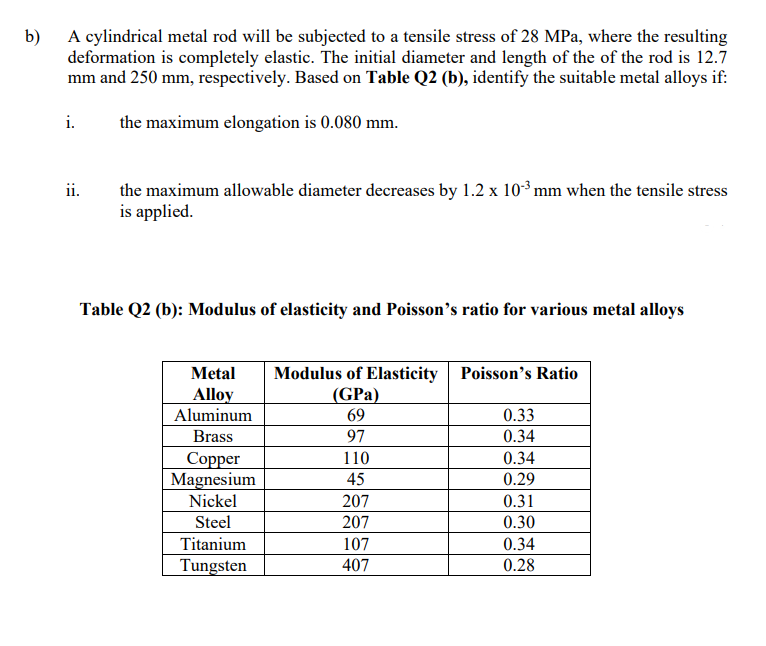b) A cylindrical metal rod will be subjected to a tensile stress of 28 MPa, where the resulting deformation is completely elastic. The initial diameter and length of the of the rod is 12.7 mm and 250 mm, respectively. Based on Table Q2 (b), identify the suitable metal alloys if: i. the maximum elongation is 0.080 mm. the maximum allowable diameter decreases by 1.2 x 103 mm when the tensile stress is applied. ii. Table Q2 (b): Modulus of elasticity and Poisson's ratio for various metal alloys Metal Modulus of Elasticity Poisson's Ratio Alloy Aluminum (GPa) 69 0.33 Brass 97 0.34 Copper Magnesium 110 45 0.34 0.29 Nickel 207 0.31 Steel 207 0.30 Titanium 107 0.34 Tungsten 407 0.28
b) A cylindrical metal rod will be subjected to a tensile stress of 28 MPa, where the resulting deformation is completely elastic. The initial diameter and length of the of the rod is 12.7 mm and 250 mm, respectively. Based on Table Q2 (b), identify the suitable metal alloys if: i. the maximum elongation is 0.080 mm. the maximum allowable diameter decreases by 1.2 x 103 mm when the tensile stress is applied. ii. Table Q2 (b): Modulus of elasticity and Poisson's ratio for various metal alloys Metal Modulus of Elasticity Poisson's Ratio Alloy Aluminum (GPa) 69 0.33 Brass 97 0.34 Copper Magnesium 110 45 0.34 0.29 Nickel 207 0.31 Steel 207 0.30 Titanium 107 0.34 Tungsten 407 0.28
Elements Of Electromagnetics
7th Edition
ISBN:9780190698614
Author:Sadiku, Matthew N. O.
Publisher:Sadiku, Matthew N. O.
ChapterMA: Math Assessment
Section: Chapter Questions
Problem 1.1MA
Related questions
Question

Transcribed Image Text:b)
A cylindrical metal rod will be subjected to a tensile stress of 28 MPa, where the resulting
deformation is completely elastic. The initial diameter and length of the of the rod is 12.7
mm and 250 mm, respectively. Based on Table Q2 (b), identify the suitable metal alloys if:
i.
the maximum elongation is 0.080 mm.
the maximum allowable diameter decreases by 1.2 x 103 mm when the tensile stress
is applied.
ii.
Table Q2 (b): Modulus of elasticity and Poisson's ratio for various metal alloys
Metal
Modulus of Elasticity Poisson's Ratio
Alloy
Aluminum
(GPa)
69
0.33
Brass
97
0.34
110
Соpper
Magnesium
Nickel
0.34
45
0.29
207
0.31
Steel
207
0.30
Titanium
107
0.34
Tungsten
407
0.28
Expert Solution
This question has been solved!
Explore an expertly crafted, step-by-step solution for a thorough understanding of key concepts.
Step by step
Solved in 3 steps

Knowledge Booster
Learn more about
Need a deep-dive on the concept behind this application? Look no further. Learn more about this topic, mechanical-engineering and related others by exploring similar questions and additional content below.Recommended textbooks for you

Elements Of Electromagnetics
Mechanical Engineering
ISBN:
9780190698614
Author:
Sadiku, Matthew N. O.
Publisher:
Oxford University Press

Mechanics of Materials (10th Edition)
Mechanical Engineering
ISBN:
9780134319650
Author:
Russell C. Hibbeler
Publisher:
PEARSON

Thermodynamics: An Engineering Approach
Mechanical Engineering
ISBN:
9781259822674
Author:
Yunus A. Cengel Dr., Michael A. Boles
Publisher:
McGraw-Hill Education

Elements Of Electromagnetics
Mechanical Engineering
ISBN:
9780190698614
Author:
Sadiku, Matthew N. O.
Publisher:
Oxford University Press

Mechanics of Materials (10th Edition)
Mechanical Engineering
ISBN:
9780134319650
Author:
Russell C. Hibbeler
Publisher:
PEARSON

Thermodynamics: An Engineering Approach
Mechanical Engineering
ISBN:
9781259822674
Author:
Yunus A. Cengel Dr., Michael A. Boles
Publisher:
McGraw-Hill Education

Control Systems Engineering
Mechanical Engineering
ISBN:
9781118170519
Author:
Norman S. Nise
Publisher:
WILEY

Mechanics of Materials (MindTap Course List)
Mechanical Engineering
ISBN:
9781337093347
Author:
Barry J. Goodno, James M. Gere
Publisher:
Cengage Learning

Engineering Mechanics: Statics
Mechanical Engineering
ISBN:
9781118807330
Author:
James L. Meriam, L. G. Kraige, J. N. Bolton
Publisher:
WILEY